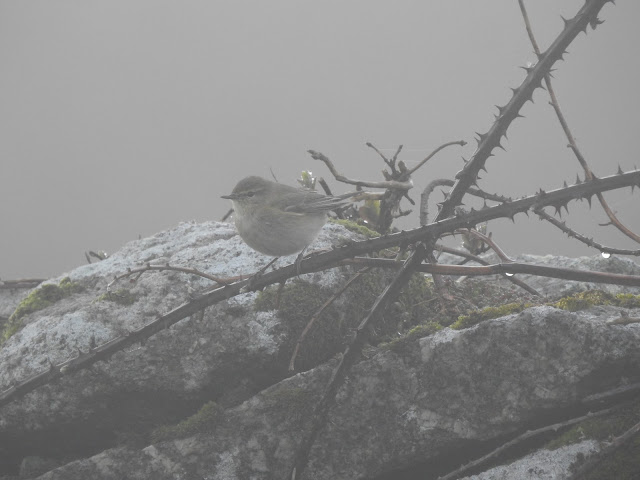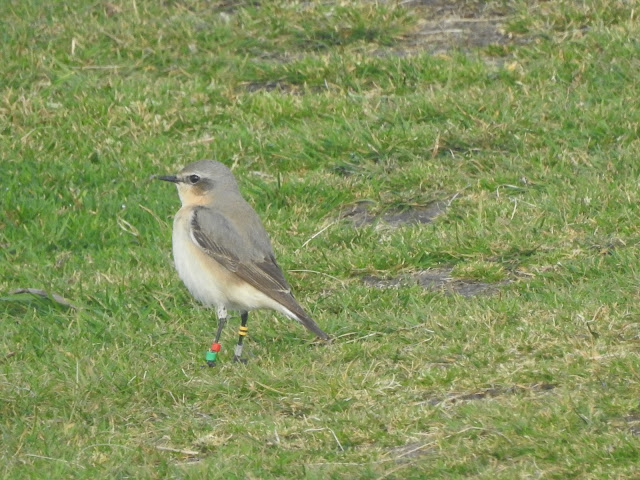Continued moderate and strong winds from the north and west for most of the week with rain and low cloud. Light winds from the 17th allowed for a large number of migrants to arrive on the island.
After a period of absence the female Shoveler was seen on Quarter’s Pond on 13th. A male Red-breasted Merganser was also briefly seen in the Landing Bay. The Hooded Crow flew over the Church on 14th and the same day as the last sighting of the Stock Dove. The Jackdaw is still present.
Single Golden Plover were recorded on 13th, 15th and 16th. A
total of six Snipe were seen on 17th. All nine Purple Sandpipers were still present on 19th. A Buzzard was seen in the morning of 17th
and then again heading south mobbed by nine Ravens. It was seen again over the
East Coast on the morning of 18th and then in the afternoon off Rat Island,
again being harassed by Ravens. Two Kestrel were seen in Millcombe on 19th. The
Sparrowhawk was also seen all week. The Merlin was last seen on 17th. A total
of six Peregrine were counted on 19th, including a few pairs taking up
territories.
 |
| Purple Sandpiper, Brazen Ward © Stuart Cossey |
 |
| Peregrine, Jenny's Cove © Stuart Cossey |
A total of 195 Puffin were counted between the Battery and
Jenny’s Cove including at least 14 on land. The night of 17th also saw the
first Manx Shearwater ringing session. Only 7 new birds were ringed as well as
two retraps. Around 30 birds were heard and seen. A Great Northern Diver was
seen in the Landing Bay on 13th, 15th and 18th. Two Red-throated Diver were
seen on 15th with singles on 14th and 16th.
 |
| Manx Shearwater, West Coast © Stuart Cossey |
The first Sand Martin was seen on 17th followed by 10+ on
18th and 46 on 19th. The first Swallow was seen on 16th and the first House
Martin of the year was seen on 19th. The first Blackcap of the year was a male
in Millcombe on 17th. A Mistle Thrush was calling in Millcombe first thing and
a Redwing was by the Water Tanks.
The low cloud in the morning of on 18th brought in a large number of
Chiffchaff with at least 33 seen up to midday. As
well as Chiffchaff there were three Blackcap, two Firecrest and eight
Goldcrest. Most of the Chiffchaff had moved on by 19th with only six seen as
well as three Firecrest and three Goldcrest.
 |
| Chiffchaff, Quarter Wall © Stuart Cossey |
Wheatear started trickling through with one on 16th. There were at least two on 18th and 21 were counted up to Halfway Wall on 19th. Some had Lundy colour-rings and were obviously back on territory after making their way back from Sub-Saharan Africa for at least the first time. Stonechat were also arriving back on territory with 10 counted on 19th.
 |
| Female Wheatear, West Coast © Stuart Cossey |
 |
| Male Wheatear, West Coast © Stuart Cossey |
Meadow Pipits were moving through in large numbers particularly on 14th (300), 17th(120), 18th(132) and 19th (294). Moving with the Meadow Pipits was a small number of alba Wagtails with a high count of 10 on 18th including four confirmed Pied Wagtail. A continental White Wagtail was in Barton Field on 19th. Two Grey Wagtail flew over on 16th.
It is still quiet for finches with only two Linnet on 16th
and one on 19th. A Goldfinch was seen on 17th and two on 18th and 19th. Two
male Brambling were reported by Quarter Wall Pond on 19th.
On non-avian news, a Red Admiral was seen by the Earthquake on 16th and 19th. The first successful moth trap of the year yielded 5 moths including a migrant Dark-sword Grass.
 |
| Dark-sword Grass moth © Stuart Cossey |
Contributors: Stuart Cossey, Rosie Ellis, Matt Stritch, Neil Trout, Andy Jayne, Dave Oddy
No comments:
Post a Comment